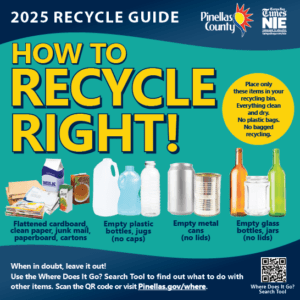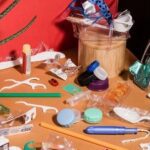Recycling FAQ
What is Mixed Recycling?
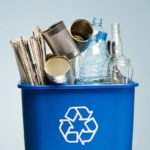
Mixed recycling or single-stream recycling is a system in which household plastic, glass and metal containers, and dry paper and cardboard are placed in a single bin or cart.
These recyclables are collected by a truck and taken to a Materials Recovery Facility (“MRF” pronounced “MuRF”) to be sorted into bales and sold to buyers who turn the material into new products.
What items belong in Mixed Recycling?

Place these items in curbside or drop-off bins and carts:
- Glass bottles and jars
- Plastic bottles and jugs
- Metal food and drink cans
- Food and drink cartons
- Paper and cardboard
All items should be clean, dry, and empty (a quick rinse is all that is needed). Leave out the caps and lids.
Visit the Pinellas County Recycle Guide to learn more.
The above items are accepted in mixed recycling curbside and drop-off programs in Pinellas County; however, always check your local recycling program rules.
What items don't belong in Mixed Recycling?
These items do not belong in mixed recycling carts and bins:
- bagged recycling
- plastic bags
- plastic packaging and wrap
- foam packaging products (i.e., to-go containers)
- food and liquids
- tanglers (cords, wires, hoses, and tarps)
- batteries
Remember: “When in doubt, leave it out.” That’s because local recycling programs are designed to recover typical household plastic, glass and metal containers, and dry paper and cardboard. Not all plastics and metals can be recycled in local programs.
How do I participate in Mixed Recycling?
Curbside:
- If you live in a city or town, they will provide you with information on how to start curbside recycling collection service.
- If you live in an unincorporated area, you may contact several licensed haulers and request quotes for recycling collection service.
- If you live in the East Lealman community, please visit this webpage for more information.
Drop off: Wherever you live in Pinellas County, bring mixed recycling to these free recycling drop-off centers. Click on a blue “recycle symbol” icon for the address, list of accepted items and other information.
What do numbers on plastic containers mean?
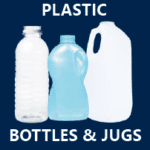
Plastic items may be labeled with a recycling symbol with a number called a Resin Identification Code (RIC). Consumers often assume this code means a package is automatically recyclable, but that’s not the case. Packages with the code may or may not be recyclable.
For example, a plastic bag and a plastic bottle may both have a recycle symbol with the #2, but plastic bags are not recyclable in mixed recycling programs. Foam food trays may have a #6, but foam packaging is not recyclable in mixed recycling programs.
In Pinellas County, it’s best to recycle items based on the size and shape of the container. If a plastic container has an opening that is smaller than the base or neck, then it is considered a plastic bottle or jug and is recyclable. Otherwise, it is best to leave it out of your mixed recycling bin.
Does plastic recycling work?
The National Waste & Recycling Association’s (NWRA) article “Dispelling Plastic Recycling Myths” states that plastic bottles and jugs are recyclable and are being recycled. This article supports Pinellas County’s list of recyclable materials, which includes plastic bottles and jugs. For example, 29.1% of PET bottles (e.g. plastic water bottles), 29.3% of natural HDPE bottles (e.g. milk jugs), and 18.1% of colored HDPE (e.g. laundry detergent bottles) were recycled in 2018, according to the United States Environmental Protection Agency’s most recent report. The NWRA is a trade association that represents private waste and recycling companies; its members are the companies that are the sorting and marketing recyclable materials.
Is there a size limit for items in Mixed Recycling?
Do plastic bags belong in Mixed Recycling?
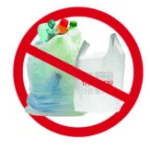
No.
- Bagged recyclables can’t be sorted by recycling equipment. Place recyclables “unbagged” into recycling carts or local drop-off centers.
- Plastic bags get tangled in recycling equipment. Return plastic bags to participating retailers. If you can’t return bags to retail locations, it’s okay to throw them away in the garbage since the County uses a Waste-to-Energy facility for disposal – turning garbage into renewable electricity.
When should I check Mixed Program rules?
To be sure you are recycling correctly, check your recycling program rules if you have questions at least once a year. Recycling technology, contracts, facilities, and processes change, so recycling program rules may have changed, too. If you have questions, contact your local recycling program representative.
How can I find recycling options?

Visit the Where Does it Go? Search Tool, a searchable database that connects you to the right donation centers, recyclers, online takeback programs, and more.
What is recycling "contamination?"
Contamination happens when residents attempt to recycle items that can’t be recovered in single-stream residential recycling programs. Contamination increases recycling costs and degrades the quality of materials, reducing the ability of the materials to be recycled.
Examples of contamination are:
- Plastic bags, cords, wires, tarps, and hoses jam and damage recycling sorting equipment. Trash these tanglers to help keep equipment working to recycle items that can successfully be recovered.
- Soiled food containers or paper can’t be recovered and can contaminate clean, quality recyclables.
- Electronics or clothing can’t be recovered in mixed, residential drop-off or curbside recycling collection programs, but may be recyclable at specific locations and other collection programs within Pinellas County.
Help contribute to the success of recycling programs by reviewing what can and cannot be recycled by visiting the Recycle Guide or Tampa Bay Recycles.
What is the County's contamination rate?
According to the 2024 Municipal and County Recyclable Materials Composition Study, the County’s contamination rate was 21.7%.
This means that one out of every five pounds of what residents put in curbside and drop-off recycling bins wasn’t recyclable! The top contaminants identified in the 2024 study were plastic bags, tanglers such as cords, ropes, and hoses, foam packaging products, food waste and food residue, batteries and yard waste.
Is recycling separated from garbage?
No recyclable materials (other than metals) are removed from garbage after it arrives at the County’s Solid Waste Disposal Complex, which includes a Waste-to-Energy Facility (WTE) and a landfill.
To recycle an item, place it in your curbside or drop-off recycling bin or cart.
Where does my recycling go?
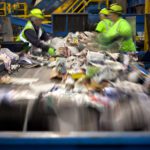
Recyclable materials are collected by a truck and taken to a Materials Recovery Facility (MRF pronounced “MuRF”) to be sorted into various commodity streams, marketed to end users, and turned into new products. Private entities operate a handful of MRFs located in Pinellas and Hillsborough Counties that service the Tampa Bay area. Pinellas County Solid Waste does not operate a MRF.
Watch this video to see a local MRF in action.
Is burning waste considered "recycling?"
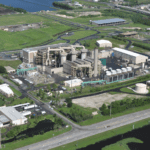
No. While the Pinellas County’s Waste-to-Energy Facility (WTE) process provides a beneficial use for garbage by reducing its volume and creating electricity, WTE is considered energy recovery, not recycling. According to EPA’s Waste Management Hierarchy, recycling is more preferred than energy recovery because it saves natural resources by avoiding the depletion of virgin materials.
To recycle an item, place it in your curbside or drop-off recycling bin or cart.
What percentage of waste could be recycled?
According to the 2025 Waste Composition Study, 11.6% of the waste arriving at the Solid Waste Disposal Complex was recyclable material, such as paper, cardboard, and plastic, glass, and metal containers; these items could have been recycled through curbside and drop-off recycling programs.
Yard waste and food waste contributed 26% of incoming waste.
All told, 37.6% of incoming waste could have been recycled or composted.
How much does Pinellas County recycle?
In 2024, the County’s recycling rate was 62%. The Florida Department of Environmental Protection requires that all counties report their recycling rates each year. A county’s recycling rate is the percentage of tons recycled divided by the total tons disposed and recycled.
There is still room for improvement. According to the County’s 2025 Waste Composition Study, 11.6% of incoming waste was recyclable material, such as paper, cardboard, and plastic, glass, and metal containers; items that could have been recycled through local curbside and drop-off recycling programs.
Current and past recycling rates can be found on the Florida Department of Environmental Protection website. Click on “County Recycling Reports,” select “Pinellas County” from the table, then open the PDF document. Scroll down to the “Recycling Rate” section of the document.
How does the County support recycling?
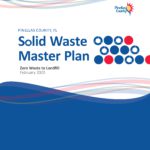
Pinellas County Solid Waste has a 30-year Solid Waste Master Plan with a goal of “zero waste to landfill by 2050.” The Master Plan proposes strategies to expand commercial and residential recycling and waste reduction programs, which is a step in the right direction toward extending the life of the one and only active landfill in Pinellas County.
Learn about the County’s strategies for maximizing recycling programs in its 30-year Solid Waste Master Plan and the timeline in the Implementation Plan.
Additional Resources
- Where Does It Go? Search Tool
- Recycle Guide & Downloadable Signage
- Household Chemical Collection
- Collection: Garbage & Recycling
- Hours: Solid Waste Disposal Complex
- Disposal Fee Information
- Educational Resources: Garbage and Recycling
- Recycling FAQ
- Map of Recycling Drop-Off Centers
- Artificial Reef Program
- Mulch Pickup Program
- For Businesses: Garbage & Recycling Resources
- How Mixed Recycling Works In Pinellas County
- Video Library: Garbage and Recycling
- Holiday and Gift-Giving Guide
- Pinellas Partners in Recycling
- Waste-to-Energy Facility
- Bridgeway Acres Landfill
- Solid Waste Master Plan
- Solid Waste Disposal Accounts
- Lealman Garbage and Recycling Collection
- Tampa Bay Recycles
- Why Recycling Is Important
- Discover Careers with Pinellas County Solid Waste
Have more questions about recycling?
Email us at recycle@pinellas.gov.
Updated on Oct. 27, 2025.
